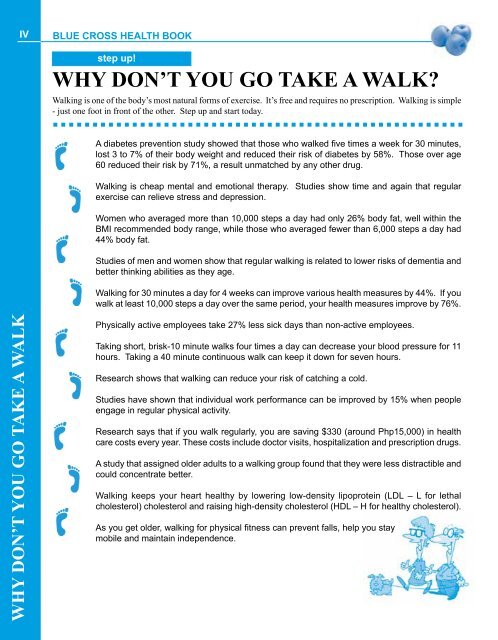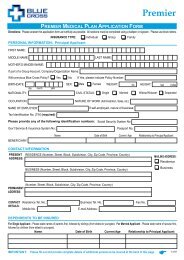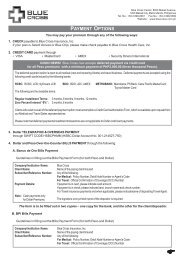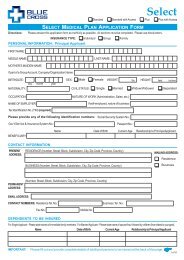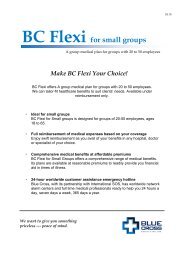Health Book_03-Special Features_2011_web.pdf - Blue Cross
Health Book_03-Special Features_2011_web.pdf - Blue Cross
Health Book_03-Special Features_2011_web.pdf - Blue Cross
You also want an ePaper? Increase the reach of your titles
YUMPU automatically turns print PDFs into web optimized ePapers that Google loves.
IV<strong>Blue</strong> cross <strong>Health</strong> BOOKstep up!WHY DON’T YOU GO TAKE A WALK?Walking is one of the body’s most natural forms of exercise. It’s free and requires no prescription. Walking is simple- just one foot in front of the other. Step up and start today.A diabetes prevention study showed that those who walked five times a week for 30 minutes,lost 3 to 7% of their body weight and reduced their risk of diabetes by 58%. Those over age60 reduced their risk by 71%, a result unmatched by any other drug.Walking is cheap mental and emotional therapy. Studies show time and again that regularexercise can relieve stress and depression.Women who averaged more than 10,000 steps a day had only 26% body fat, well within theBMI recommended body range, while those who averaged fewer than 6,000 steps a day had44% body fat.Studies of men and women show that regular walking is related to lower risks of dementia andbetter thinking abilities as they age.Walking for 30 minutes a day for 4 weeks can improve various health measures by 44%. If youwalk at least 10,000 steps a day over the same period, your health measures improve by 76%.WHY DON’T YOU GO TAKE A WALKPhysically active employees take 27% less sick days than non-active employees.Taking short, brisk-10 minute walks four times a day can decrease your blood pressure for 11hours. Taking a 40 minute continuous walk can keep it down for seven hours.Research shows that walking can reduce your risk of catching a cold.Studies have shown that individual work performance can be improved by 15% when peopleengage in regular physical activity.Research says that if you walk regularly, you are saving $330 (around Php15,000) in healthcare costs every year. These costs include doctor visits, hospitalization and prescription drugs.A study that assigned older adults to a walking group found that they were less distractible andcould concentrate better.Walking keeps your heart healthy by lowering low-density lipoprotein (LDL – L for lethalcholesterol) cholesterol and raising high-density cholesterol (HDL – H for healthy cholesterol).As you get older, walking for physical fitness can prevent falls, help you staymobile and maintain independence.


